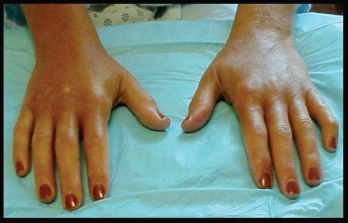
American College of Rheumatology
CHICAGO—Can non-drug interventions improve the lives of patients with scleroderma? Janet L. Poole, PhD, OTR/L, professor and director of the Occupational Therapy Graduate Program of the School of Medicine, University of New Mexico, Albuquerque, addressed this question when she presented the ARHP Distinguished Lecture at the 2018 ACR/ARHP Annual Meeting. She discussed the challenges faced by people with scleroderma as they manage their daily activities and summarized the evidence for non-pharmacological interventions for symptom management to improve the quality of life for these patients.
Disease Overview
Scleroderma, also known as systemic sclerosis, is a rare connective tissue disease that results in skin thickening, vascular insufficiency and fibrosis of internal organs. Approximately 60,000–100,000 people in the U.S. have the systemic form of scleroderma, a multi-system disease that includes organ involvement. People with scleroderma can develop painful calcium deposits under the skin on the fingers and over some larger joints, and they may have difficulty with swallowing due to problems moving food through the esophagus, Dr. Poole explained.
About 95% of people with scleroderma have Raynaud’s phenomenon and may develop digital ulcers as a result of vascular problems. Contractures can develop in the finger joints; people may lose the ability to fully straighten the middle joints of the fingers. This type of joint contracture translates to an increased likelihood the patient will bump the joint, forming ulcers that may be slow to heal due to ischemia and repeated irritation. Ulcers and joint contractures can result in decreased motion, dexterity and function in the hand. Because use of the hands is necessary for most activities of daily living, these impairments can have a significant negative effect on quality of life.
Scleroderma can cause a change in facial appearance as well, Dr. Poole stated. The skin on the face can become tight and, in some people, spidery blood vessels can appear on the face. Tight facial skin and fibrosis of the tendons can lead to decreased mouth opening. That, in turn, can make oral and dental care more difficult.
Earlier diagnosis and more effective medical and pharmacological treatment have meant people are living longer with scleroderma and experience more disability in their work, family and social lives. Between five and 10 years following diagnosis, approximately one-third of patients are work disabled, and by 20 years post-diagnosis, more than half of patients are work disabled. However, as the disease progresses, Dr. Poole explained, many patients learn to adapt and secure support.



